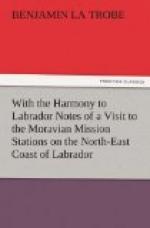/\
/ \
/ \
/ D. \
/ \
/ 1778. \
/ \
\ Sep. 18. /
\ /
\ /
\ /
\ /
\ /
\/
I will close this chapter with a contrast. Leaving the peaceful Christian burial ground, we climb the hill behind the station. In a lofty, lonely valley we find many heaps of great stones. We will examine one. Remove one or two of the boulders, and look in. On the ground, rather than in it, lies a human skeleton, perfect with the exception of the skull. We go on to the next heap; it is empty. In a third we find a skull and one or two bones. Others contain scarcely any human remains, but some Eskimo utensils were evidently the property in life of the natives whose bodies were laid there by their countrymen. It was customary to bury the possessions of the dead with them, and very interesting curiosities used to be found in all these graves.
Yes, these are heathen graves, and the bodies in them are those of Eskimoes who have died, ere they heard the words of life from the lips of missionaries sent by the Church of Christ to proclaim His salvation at this end of the earth. No inscriptions mark the tombs of these nameless pagans, yet those rude stoneheaps have a voice for those who have ears to hear. Methinks they appeal loudly on behalf of myriads still living without God and dying without hope. “How shall they believe in Him of whom they have not heard, and how shall they hear without a preacher, and how shall they preach except they be sent?”
A BUSY WEEK AT NAIN.
The week spent at Nain may serve as a specimen of my stay at each station in turn. We arrived here on Sunday, August 19th, in the evening. Monday and part of Tuesday were taken up by conferences on the spiritual prosperity and temporal regulations of the. Labrador Mission. Tuesday afternoon proved the most convenient time for my special meeting with the congregation, when, as at every station, I gave the assembled men and women the greeting and message sent them by the mission authorities at home. Opportunity being afforded them to reply, some of the native helpers and others expressed their pleasure that a visitor had come from Europe, and their gratitude that Christians on the other side of the ocean had sent missionaries to their forefathers, and still maintained teachers among them. They also asked questions and gave their opinions on very various topics. I promised to convey their salutations to “their angayokaks in London and Herrnhut.” This meeting lasted about two hours, and was, as elsewhere, an arduous time for the missionary who acted as my interpreter. It seemed easier to him to render into Eskimo my own address given in English, than to interpret all the speeches made by the natives in reply.




